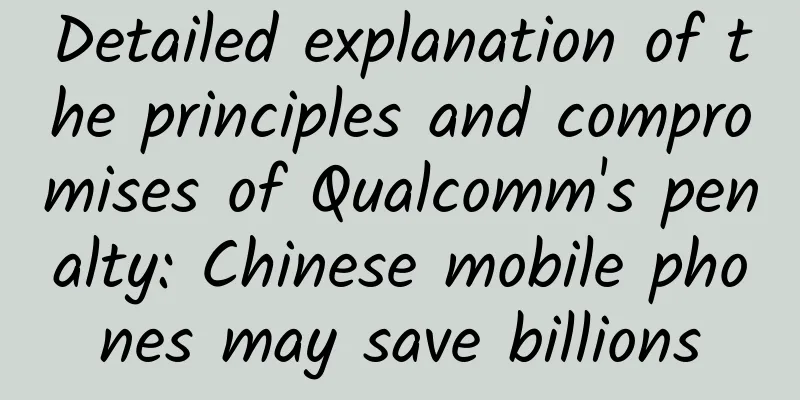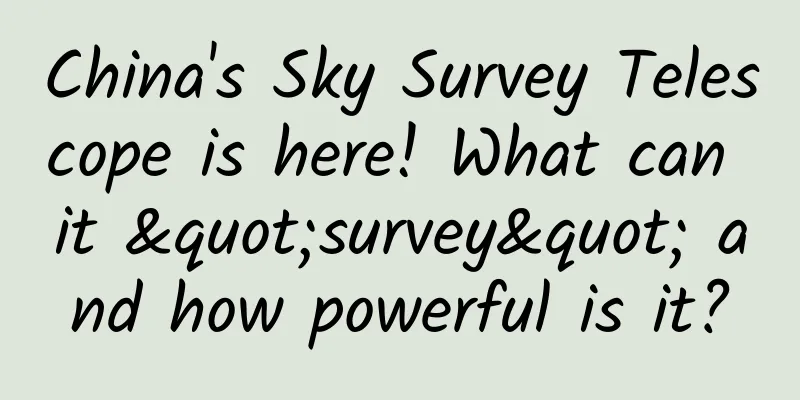Detailed explanation of the principles and compromises of Qualcomm's penalty: Chinese mobile phones may save billions

|
There are more details to be revealed about China's antitrust investigation into Qualcomm, which has attracted global attention . On February 10, China's National Development and Reform Commission announced a fine of 6.088 billion yuan against US chip giant Qualcomm. Xu Kunlin, director of the Price Supervision and Anti-monopoly Bureau of the National Development and Reform Commission, told a reporter from China Business News that the full text of the penalty notice will be released in a few days. He disclosed some details of the investigation at a briefing held that day, such as that he personally met with the president of Qualcomm eight times. Qualcomm had applied for a hearing, but they withdrew the application at the last minute. Qualcomm itself said that it would not seek defense. After Qualcomm corrects (the illegal behavior), its development in China is encouraged. "He said. The NDRC said that this antitrust enforcement has stopped Qualcomm's monopolistic behavior, maintained fair competition order in the market, and protected consumer interests. Huang Wei, the head of Tianyuan's antitrust team and secretary-general of the Antitrust Committee of the All-China Lawyers Association, who was deeply involved in the case, has an estimate of the benefits of this investigation to Chinese brand mobile phones. He told our reporter that the reduction in patent licensing fees is expected to save Chinese brand mobile phone companies tens of billions of yuan in expenses each year. How to calculate 6.088 billion yuan On February 10, the National Development and Reform Commission announced that it had ordered Qualcomm to rectify its monopolistic behavior and fined it 6.088 billion yuan. The NDRC said that Qualcomm had abused its dominant market position in three ways: charging unfairly high patent licensing fees; bundling non-wireless communication standard essential patent licenses without justifiable reasons; and attaching unreasonable conditions to the sale of baseband chips. The final penalty amount in this case reached the highest level in domestic history, more than three times the total amount of antitrust fines in 2014 (according to rough statistics in 2014, the NDRC issued a total of 1.8 billion yuan in antitrust fines throughout the year). The fine imposed on Qualcomm is sky-high, but not absolutely severe. According to the provisions of China's Anti-Monopoly Law, if an operator violates the regulations and reaches and implements a monopoly agreement, the illegal gains can be confiscated and a fine of more than 1% and less than 10% of the previous year's sales can be imposed. Xu Kunlin said at the above briefing that the fine was not the main purpose. Because Qualcomm cooperated well with the investigation and the company's president visited the NDRC many times, the NDRC did not impose the highest penalty of 10%, but reduced it by 2% to 8%. "Qualcomm initially thought the fine was a bit heavy, but we thought it was reasonable and Qualcomm finally accepted it. The fine was calculated based on the average exchange rate of the State Administration of Foreign Exchange," he said. The NDRC’s announcement stated that Qualcomm was fined 8% of its sales in the Chinese market in 2013, totaling 6.088 billion yuan. Previously, this newspaper reported that unlike the EU, which calculates the base based on the global turnover of all types of products in the previous year, China's antitrust department, like South Korea, only calculates the turnover sold in China, and only the products related to the investigated behavior are counted. "The EU's practice is that if a branch makes a mistake, the turnover of the entire parent company needs to be included as the base; if in addition to chips, medicines are also produced, the medicines must also be included as the base." said Zhou Zhaofeng, a doctorate in antitrust law from the University of Glasgow and a partner at the UK Honghu Law Firm. The NDRC explained that “relevant turnover” refers to limited products and related markets. For example, in the previous milk powder antitrust case, only the milk powder business of the relevant enterprises was counted, while the milk powder raw materials with large output were not included in the base. Public data shows that Qualcomm's global sales in 2013 were US$24.87 billion, of which sales in China (including Hong Kong) reached US$12.288 billion, accounting for nearly 50%. The fine amount is calculated based on 8% of the US$12.288 billion in sales in the annual report, which is US$983.04 million, or about RMB 6.148 billion after conversion based on the latest RMB-USD exchange rate of 6.2541. This is slightly different from the final fine of US$6.088 billion. An insider who is familiar with the progress of the case analyzed to the reporter of "China Business Daily" that this error may be mainly due to the fact that the relevant sales do not include Hong Kong, China; the sales mentioned in the annual report refer to the sales of Qualcomm's "all businesses", while the relevant markets defined in the penalty decision are the 2G, 3G, and 4G wireless communication standard essential patent markets and the CDMA, WCDMA, and LTE baseband chip markets; Qualcomm's annual report calculated the sales for 2013 during the US fiscal year (i.e. October 2012 to September 2013), while the fines previously imposed by the National Development and Reform Commission were generally calculated based on the Chinese fiscal year (i.e. January to December 2013). The two sides communicated 28 times Xu Kunlin revealed that the NDRC listed all the illegal acts during the first meeting with Qualcomm, but asked Qualcomm to go back and prepare. The two sides communicated 28 times, of which Xu Kunlin personally met with the president of Qualcomm 8 times. During more than 20 communications, Qualcomm's lawyers were present. The China Business News previously reported that the NDRC's penalty decision was only an administrative penalty. If Qualcomm is dissatisfied, it can ask the court to conduct a judicial review. During the judicial review process, the first instance can be held. If the decision is not satisfied, an appeal can be made, and the second instance can be held as the final instance. Even if the NDRC's administrative penalty is made, the case still has a long legal process to go through. Judging from the investigation process disclosed so far, Qualcomm has not raised any defense. The NDRC announcement stated that Qualcomm proactively proposed a package of rectification measures, which mainly include five points: For mobile phones sold for use in my country, a patent licensing fee of 65% of the net wholesale price of the whole device is charged; When granting patent licenses to Chinese licensees, a patent list will be provided, and no licensing fees may be charged for expired patents; There is no requirement for Chinese licensees to provide free reverse licensing of patents; When licensing wireless standard essential patents, non-wireless communication standard essential patent licenses shall not be bundled without justifiable reasons; When selling baseband chips, Chinese licensees will not be required to sign license agreements containing unreasonable conditions, and not challenging patent license agreements will not be a condition for supplying baseband chips to Chinese licensees. The NDRC said that the package of rectification measures submitted by Qualcomm met the agency's decision and rectification requirements. According to previous reports of this newspaper, this involves the rectification of some of Qualcomm's core business models. Qualcomm's so-called "free reverse licensing" means that Qualcomm requires mobile phone companies that purchase Qualcomm chips to reverse license their standard essential patents and even non-standard essential patents to Qualcomm free of charge. For example, if mobile phone company A purchases Qualcomm chips, it must reverse license its standard essential patents and even non-standard essential patents to Qualcomm free of charge. When Qualcomm sells the chips to another mobile phone manufacturer B, the company no longer has to pay patent fees to mobile phone company A. Through free reverse licensing, Qualcomm indirectly owns a very high share, or perhaps even most, of the rights to use standard essential patents in the field of wireless communication standards. These include both patents it owns and patents granted by Chinese companies that it reverse licenses free of charge. The significance of "charging patent licensing fees at 65% of the net wholesale price of the whole machine" has also attracted attention in the industry. What was previously unfair to industry insiders was that Qualcomm's patent fees were charged based on the price of the entire device, while the common method of charging patent fees was to use the patented part as the basis for calculating the proportion. Coupled with the excessively high patent licensing fees, Qualcomm's model was described by industry insiders as "rogue behavior", and Qualcomm was essentially more like a company that relied on patent fees to make profits. What is the concept of charging for the whole device? An industry insider gave an analogy: For example, if you invented a lighting method for electric lamps, if the manufacturer of electric lamps uses this patent and produces electric lamps, according to the negotiation results, 3% to 5% of the turnover will be compensated to you as patent fees. If your patent is about light bulbs, then you will be paid when you sell the light bulbs, which is 3% to 5% of the price of the light bulbs. However, the light bulb has a beautiful base outside, and the whole lamp ultimately costs 100 yuan. According to Qualcomm's method, the patent fee is charged based on the 100 yuan base of the whole lamp. Chinese mobile phone brands may save billions Several lawyers and experts in the industry who requested anonymity commented to China Business News that, judging from the above description, the biggest change to Qualcomm's business model is the cancellation of free reverse licensing; it seems that the rate has been reduced by 35%, but the patent pricing model based on the net wholesale price of the whole device has not been changed. In addition, due to factors such as the failure to give a rate, some industry insiders are worried that some of Qualcomm's commitments may be circumvented in the future. Xu Kunlin said that antitrust enforcement will not protect certain companies, but is mainly aimed at restoring the competitive order. In addition, the transmission of changes in mobile phone prices takes time, which will eventually lead to improved product technology, improved quality and lower prices. "But this requires a process, and everyone needs to be patient. In the end, consumers will benefit," said Xu Kunlin. Lawyer Huang Wei is more optimistic. He did some calculations for our reporter. According to Canalys' retail monitoring data, the sales volume of China's mobile phone market in 2014 was about 387 million units, and the share of domestic brands exceeded 70%. According to the average level, the patent licensing fee collected by Qualcomm is about 5% of the sales price of the whole device. After this penalty, the sales price collection ratio was adjusted to 65% of the original ratio. If calculated based on RMB 1,000 per mobile phone and a licensing fee rate of 5%, a rough estimate of 35% discount means that Chinese companies can reduce their expenditure by about tens of billions of yuan a year. He analyzed that Qualcomm's relevant rectification measures also mean that mobile phone manufacturers can choose to sign a licensing agreement with Qualcomm for a certain patent without having to sign an overall package patent agreement. Huang Wei commented to the reporter of China Business News that this case took more than a year from the initiation of the investigation to the official announcement of the investigation results. It is currently the largest antitrust investigation case in China with the most direct confrontations, the greatest investigation difficulty, the highest penalty amount, and the most far-reaching subsequent impact. As a winner of Toutiao's Qingyun Plan and Baijiahao's Bai+ Plan, the 2019 Baidu Digital Author of the Year, the Baijiahao's Most Popular Author in the Technology Field, the 2019 Sogou Technology and Culture Author, and the 2021 Baijiahao Quarterly Influential Creator, he has won many awards, including the 2013 Sohu Best Industry Media Person, the 2015 China New Media Entrepreneurship Competition Beijing Third Place, the 2015 Guangmang Experience Award, the 2015 China New Media Entrepreneurship Competition Finals Third Place, and the 2018 Baidu Dynamic Annual Powerful Celebrity. |
<<: Alibaba-Meizu marriage: ambitions and lies in the new ecological era
>>: Alibaba and SAIC: What handshake? What peace?
Recommend
If I give you 1 million for promotion, how would you spend it? 4 major platform optimization methods, which can be copied and executed!
The original intention of writing this article is ...
The functions of WeChat are far better than before. The new version of mobile QQ has a detailed experience
Nowadays, youth versions are popular for everythi...
Toutiao’s information flow ads do not support oCPC. What is the motivation behind this?
I wrote an article about Toutiao before, which wa...
Xi'an Men's Massage and Health SPA Club, a high-end SPA with a return rate of 300%
Xi'an Bath Club East Suburbs, South Suburbs, ...
The colonoscopy results were normal, so how come he suddenly got colon cancer?
Data show that colonoscopy screening for colorect...
WOT lecturer Tingyun Technology Vice President Liao Xiongjie: APM adds wings to cloud applications
In the PC era, APM was widely used for website mo...
The name comes from "The Doctrine of the Mean", and a new "neutral" star has been added to the vast universe!
Author: Ding Lanhe Review|Liao Xi, Zou Qianyi, Zh...
How did the mercenary shout happy birthday?
The mercenary's happy birthday video was shot...
Ma Sichun lost 20 pounds in a week. What are Ma Sichun’s weight loss methods?
Yes. By adjusting her diet, Ma Sichun lost weight...
Shishi SEO training: Website optimization and ranking is a complex but important task
Website optimization and ranking is a complex but...
The robots have arrived at the International Space Station. How are they doing their job?
Yesterday was the first day of 2025, and the crew...
4 cases of Super Fans Pass, let the data speak for themselves!
We have previously introduced the new features of...
Tencent’s 6-year operations expert teaches you the SNS viral marketing model!
This article comes from the content shared in the...
Attention, tourists! Our next stop is Lung Lobe!
These four tips to increase your lung capacity: I...









